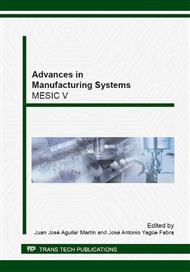p.22
p.32
p.39
p.45
p.51
p.57
p.63
p.70
p.76
Development of a Behaviour Curve for Quality Evaluation with Optoelectronic Profilometers
Abstract:
This work shows an experimental procedure aimed to generate a graph with the optimal roughness parameters in order to obtain the best roughness measurements of an optoelectronic profilometer. The optimal parameters have been determined taking into account the grade of agreement between the optical roughness values and the equivalent values of traditional contact devices. The working parameters of the optoelectronic profilometer are based on computational filters which are controlled by software working with a 3D stratified colour map (chromatic fragmentation of the white light). However, these parameters substantially differ from the usual contact profilometers that work with 2D roughness profiles (cut-off, evaluation length and contact stylus radii). This work pursues to find the optical profilometer parameters, and its values, that ensure the best quality measurement for a wide range of machining process and testing several ISO roughness intervals.
Info:
Periodical:
Pages:
51-56
Citation:
Online since:
June 2014
Price:
Сopyright:
© 2014 Trans Tech Publications Ltd. All Rights Reserved
Share:
Citation:


